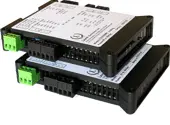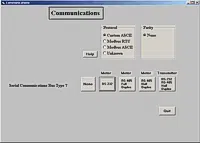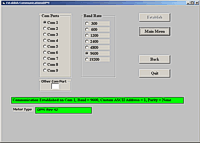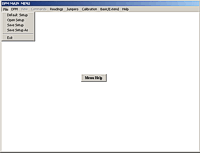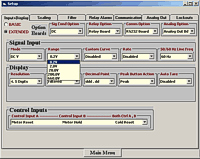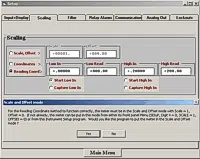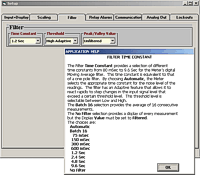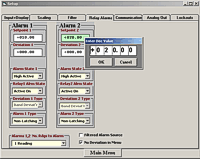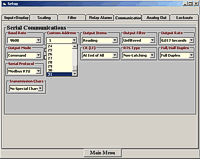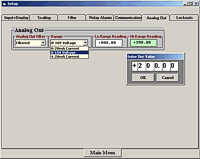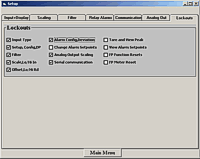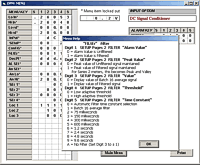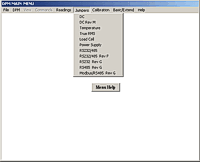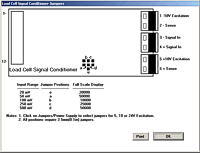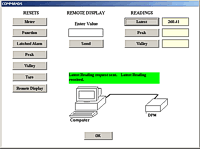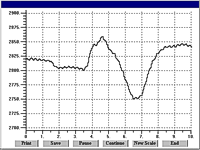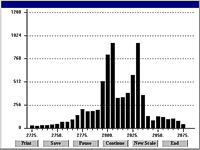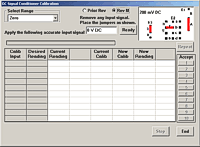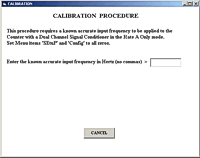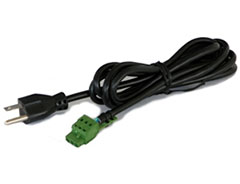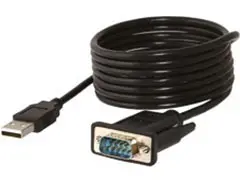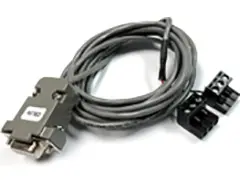Features
- Converts streaming RS232 or RS485 ASCII data to an (isolated), scaled 4-20 mA, 0-10 mA, 0-10V or -10V to +10V analog output.
- Able to retrieve data from long character strings.
- Setup using Laurel's free Instrument Setup Software.
- Accepts Modbus or Custom ASCII protocol commands to set analog output or relay action.
- Includes up to 1/2 hour of technical phone support with screen sharing.
- Serial data rates from 300 to 9600 baud.
- Analog output resolution 0.0015% of span (16 bits), accuracy ±0.02% of span.
- Dual 120 mA solid state relays can respond to readings or to control characters.
- Universal 85-264 Vac / 90-300 Vdc or 10-48 Vdc / 12-32 Vac power.
- Operating temperature from -40°C to 70°C (-40°F to 158°F)
- DIN rail mount housing only 22.5 mm wide, detachable screw-clamp connectors.
Certificates of Compliance
The LTS serial data input, analog output transmitter accepts streaming RS232 or RS485 serial data ASCII strings from an external device, like a scale, at rates up to 9600 baud. It converts this data to an (isolated), scalable 4-20 mA, 0-20 mA, 0-10V or -10V to +10V analog output. Two solid state relays are standard and can respond to readings or to received control characters. The LTS also accepts serial commands via the Modbus RTU or Laurel Custom ASCII protocols to set the analog output or relay state. The unit is housed in a transmitter case which is only 22.5 mm (0.89") thick and fits on a 35 mm DIN rail. Depending on the model, it can be powered by AC (85-264 Vac) or DC (10-48 Vdc).

Standard LTS features include:
- Streaming serial data input, RS232 or RS485. The data to be converted to analog is specified using Laurel's free Instrument Setup Software. The user-selectable "Remote C" mode allows the number of characters in the data, preceding the data and following the data to be specified. In all cases, it is essential to know know the what ASCII characters are contained in each serial data transmission.
- Commands via the Modbus RTU, Modbus ASCII or Custom ASCII protocols. For details, please or Modbus and Custom ASCII manuals. These commands can be used to set the analog output and the state of the unit's two relays. Modbus implementation is fully compliant with Modbus over Serial Line Specification V1.0 (2002) for operation, with up to 247 digital addresses.
- 4-20 mA, 0-20 mA, 0-10V or -10V to +10V analog transmitter output, (isolated), jumper-selectable and user scalable. All selections provide 16-bit (0.0015%) resolution of output span and 0.02% output accuracy of readings from -999,999 to +999,999 counts. Output isolation from signal and power grounds eliminates potential ground loops.
- Dual solid state relays for control or alarm, (isolated). Rated 120 mA at 140 Vac or 180 Vdc. The relays can respond to digital readings or to received control characters, or be commanded via the Modbus protocol or Custom ASCII protocol.
- Transmitter programming via Laurel's Instrument Setup Software, which runs on a PC under MS Windows. This software can be downloaded from this website at no charge. The required cables from the transmitters to a PC com port are available from Laurel (P/N CBL02 and CBL04).
- Up to 30 minutes of technical phone support. Programming requires an understanding of the ASCII characters in your streamed data. Setup assistance using screen sharing is built into the price of the LTS.
All signal conditioner board ranges are factory-calibrated, with calibration factors for each range securely stored in an onboard EEPROM. These factors can be scaled via software to accommodate external shunts, enabling field replacement of signal conditioner boards without necessitating recalibration of the associated transmitter. For optimal accuracy, factory recalibration is recommended annually. All Laurel Electronics instruments undergo factory calibration using the industry-leading Fluke calibrators, which are recalibrated yearly and certified traceable to national standards, ensuring the highest level of precision and reliability.
Programmable Streaming Input Modes
Six data conversion modes are user selectable to receive and process streaming data. The number of characters to be processed can be up to 7, including 6 digits and a decimal point. Include leading zeros, like 00300.0. The LTS is not plug and play. The format of the strings being received must be known in advance, including non-printing control characters. If you do not know the string format, contact tech support of the sending device's manufacturer, or use a terminal emulator program like HyperTerminal, PuTTY or RealTerm to view the actual transmitted characters.
- Remote S processes single values without a digital address. An alarm character is optional.
- Remote A processes single values with a digital address. An alarm character is optional.
- Remote 1 processes the 1st of up to 4 readings embedded in a Laureate transmission.
- Remote 2 processes the 2nd of up to 4 readings embedded in a Laureate transmission.
- Remote 3 processes the 3rd of up to 4 readings embedded in a Laureate transmission.
- Remote 4 processes the 4th of up to 4 readings embedded in a Laureate transmission.
- Remote C can process readings embedden in long ASCII strings. Specify the start character at the beginning of the string, the number of characters following the start chracter to be ignored, the number of characters to be processed following the lastignored character, and the stop character at the end of the string.
Programmable Command Modes
A Master, which can be a PC, PLC or other programmable device, can send digital values to an LTS transmitter to cause it to output specifc analog signals and actuate alarms. Ether the Modbus RTU protocol or Laurel's simpler Customer ASCII protocol can be used for commands. Both support digital addressing.
- The Modbus RTU protocol uses Function Code FC10, Holding Register 006C, and data as 4 hexadecimal bytes.
- The Custom ASCII protocol uses the string *1K followed by the decimal reading and by <CR>
Connecting Laureate LTS Transmitters to a Local Area Network (LAN)
Up to 30 Laureate LTS Transmitters and/or Digital Panel Meters can be configured for RS485 and daisy-chained to an LTS Transmitter using Laurel’s High Speed Ethernet-to-RS485 converter board for seamless LAN integration. Alternatively, Laurel LTE series Ethernet transmitters can connect directly to a LAN via an Ethernet cable. Setup for both configurations is streamlined using Laurel’s free Instrument Setup Software, which simplifies node discovery and transmitter configuration.
Flexible Communication Options for LTS Transmitters
Laureate Transmitters can be equipped with Laurel communication boards to support various interfaces and protocols. These include serial interfaces with ASCII or Modbus RTU protocols, and Ethernet interfaces with web access, ASCII, or Modbus TCP/IP protocols, ensuring versatile connectivity for your commercial applications.

Laureate LTS Serial Input, Analog Output, DIN Rail Transmitter
| Serial Data Input (standard) | ||||
|---|---|---|---|---|
| Signal Types | RS232 or RS485 (half or full duplex), jumper selectable | |||
| Data Rates | 300, 600, 1200, 2400, 4800, 9600, 19200 baud | |||
| Output Isolation | 250V rms working, 2.3 kV rms per 1 min test | |||
| Serial Protocols | Modbus RTU, Modbus ASCII, Custom ASCII | |||
| Modbus Compliance | Modbus over Serial Line Specification V1.0 (2002) | |||
| RS232/485 Connector | Screw terminals for easy daisy chaining | |||
| Digital Addresses | 247 for Modbus, 31 for Laurel ASCII | |||
| Analog Output (standard) | ||||
| Output Levels | 4-20 mA, 0-20 mA, 0-10 Vdc, -10V to +10V (user selectable) | |||
| Compliance at 20 mA | 10V (0-500Ω load) | |||
| Compliance at 10V | 2 mA (5 kΩ or higher load ) | |||
| Output Resolution | 16 bits (65,536 steps) | |||
| Output Accuracy | ±0.02% of output span | |||
| Output Update Rate | Determined by input data rate, max 10/sec | |||
| Output Isolation | 250V rms working, 2.3 kV rms per 1 minute test | |||
| Dual Relay Output (standard) | ||||
| Relay Type | Two solid state relays, SPST, normally open, Form A | |||
| Load Rating | 120 mA at 140 Vac or 180 Vdc | |||
| Power Input | ||||
| Standard Power | 85-264 Vac or 90-300 Vdc | |||
| Low Power Option | 10-48 Vdc or 12-32 Vac | |||
| Power Frequency | DC or 47-63 Hz | |||
| Power Isolation | 250V rms working, 2.3 kV rms per 1 min test | |||
| Power Consumption | 1.5W typical at 24V | |||
| Environmental | ||||
| Operating Temperature | -40°C to 70°C (-40°F to 158°F) | |||
| Storage Temperature | -40°C to 85°C (-40°F to 185°F) | |||
| Relative Humidity | 95% at 40°C, non-condensing | |||
| Cooling Required | Mount transmitters with ventilation holes at top and bottom. Leave 6 mm (1/4”) between transmitters, or force air with a fan. | |||
| Mechanical | ||||
| Enclosure | Rugged black polycarbonate housing material | |||
| Mounting | 35 mm rail per DIN EN 50022 | |||
| Dimensions | 129 x 104 x 22.5 mm case | |||
| Connectors | Detachable screw clamp connectors meet VDE / IEC / UL / CSA standards. RJ45 jack for Ethernet | |||
| Tightening Torque | Screw terminal connectors: 5 lb-in (0.56 Nm) | |||
| Weight | Complete transmitter: 183 g (6.5 oz) | |||
| General | ||||
| Programming | Utilize Laurel's free Instrument Setup Software, which runs on a PC under MS Windows. | |||
| Security | Lockout options available using Laurel's free Instrument Setup Software. | |||
| Warranty | 3 years parts & labor | |||
| Recalibration: All ranges are calibrated at the factory. Recalibration is recommended every 12 months. | ||||
Transmitter Pinout
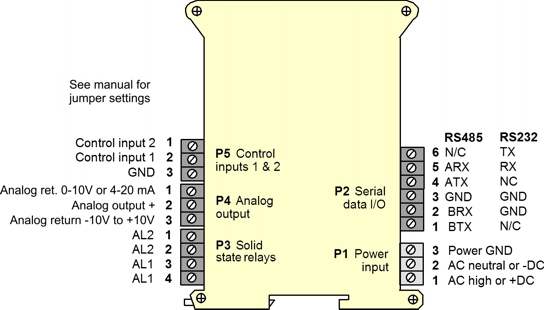
Free Instrument Setup Software for Series 2 Laureates
Free Downloadable Windows-based Instrument Setup (IS) software (Data Interface Board Required) for use with our programmable Digital Panel Meters, Scale Meters, Counters, Timers, Remote Displays, and Transmitters, are an easy method to set up Laureate 1/8 DIN digital panel meters, counters, timers, remote displays, and DIN-rail transmitters, as explained in the Instrument Setup Software Manual. Laureate 1/8 DIN instruments can also be set up from the front panel, as explained in their respective Owners Manuals. Instrument Setup software is of benefit whether or not the PC is connected to the instrument.
- When the PC is connected to the instrument, Instrument Setup software can retrieve the setup file from the instrument or open a default setup file or previously saved setup file from disk View Setup, then provides graphical user interface (GUI) screens with pull-down menus applicable to input, display, scaling, filtering, alarms, communications, analog output, and front panel lockouts. Fields that are not applicable to the instrument as configured are either left out or grayed out. Clicking on any item will bring up a detailed Help screen for that item. After editing, the setup file can be downloaded, uploaded to the instrument, or saved to a disk. The same setup file can then be downloaded into multiple instruments.
- When the PC is not connected to the instrument, the above GUI screens can be used to set up a virtual instrument. The setup file can then be saved to disk. Switching toView Menu then brings up a screen with the required front panel programming steps. This view can be printed out for use at the instrument site and to serve as a hard copy record.
Download Free Instrument Setup Software
Installation
Set User Account Control (UAC) of MS Windows to "Never notifiy me" so that Instrument Setup Software can create directories. The UAC change screen can be reached as follows:
- Under Windows 7, click on the Windows Start button in the lower left of the desktop and enter "UAC" in the search field.
- Under Windows 8, navigate to Control Panel, then to the "User Accounts and Family Safety" section, and click on "Change User Account Control Settings."
- Under Windows 10, click on the Windows Start button in the lower left of the desktop, then on "Settings", and enter "UAC" in the search field.
- Reboot your computer for the changed UAC setting to take effect.

RJ11-to-DB9 cable with rear view of DB9 connector to PC

RS232 cable, meter to PC, P/N CBL01
Laureate 1/8 DIN Laureate instruments must be equipped with a serial communications board and be connected to the computer via a serial communications cable. The connection can be via RS232, RS485, USB or Ethernet. Following setup, the serial communications board may be removed from the instrument if desired. The wiring of the RS232 cable is illustrated above with end views of the two connectors.
Laureate LT Series transmitters come standard with a 3-wire serial interface, which can be jumpered for RS232 or RS485.
Laureate LTE Series transmitters come standard with an Ethernet interface.
Meter Setup Screens
Click on any of the reduced screens below for a full-size screen view, then click on the Back button of your browser to return to this page. The screens examples below are for a fully-loaded Series 2 Digital Panel Meter (DPM), which is connected to the PC via RS232. If the meter is a Series 1 meter (pre-2007), this is sensed by the software, and somewhat different screens are brought up. Please see Series 1 setup screens.











Meter Setup Utilities




From the Main Menu, click on Readings if your PC is connected to the meter. A pull-down menu then offers three choices: List, Plot and Graph.
- List presents the latest readings in a 20-row by 10-column table. Press Pause at any time to freeze the display. This is one method to capture peak readings.
- Plot generates a plot of readings vs. time in seconds. It effectively turns the DPM-PC combination into a printing digital oscilloscope.

- Graph generates a histogram where the horizontal axis is the reading and the vertical axis is the number of occurrences of readings. The display continually resizes itself as the number of readings increases.



Dimensions
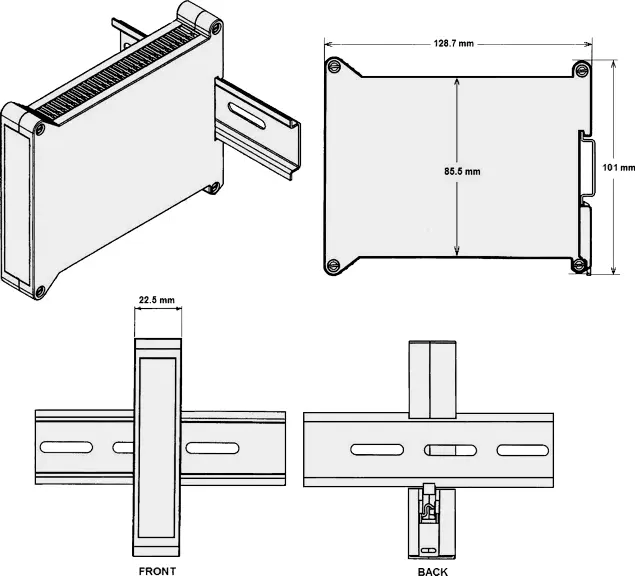
Dimensioned CAD assembly drawings in EPRT, STEP, x_t, .dwg, pdf file formats: Laureate-transmitter-case.zip (zipping prevents browser from opening CAD files as text files).
CBL02
USB-to-RS232 Adapter Cable
CBL04
RS232 Cable for LT Transmitters
What is an LTS Series DIN Rail Transmitter for RS232/485 Serial-to-Analog Converter?
In the realm of industrial automation and control systems, the ability to bridge communication protocols is essential for seamless operation. The LTS Series DIN Rail Transmitter for RS232/485 Serial-to-Analog Converter is a sophisticated device designed to facilitate this process, making it a crucial component for modern industrial applications. Let's explore what this device is, its features, and its benefits.
Understanding the LTS Series DIN Rail Transmitter
The LTS Series DIN Rail Transmitter is a specialized device that converts RS232 or RS485 serial communication signals into analog signals. These signals are then used to interface with various analog systems or devices, such as sensors, actuators, and control systems. The device is designed to be mounted on a DIN rail, which is a standard mounting system used in electrical and automation equipment.
Key Features:
-
Versatile Communication Protocols: The LTS Series supports both RS232 and RS485 serial communication protocols. RS232 is commonly used for short-distance communication, while RS485 is preferred for long-distance and multi-point systems. This versatility makes the LTS Series adaptable to various industrial environments.
-
Analog Output Options: The device provides analog output signals, typically in the form of 4-20 mA or 0-10 V. These outputs are compatible with a wide range of analog devices, allowing for easy integration into existing systems.
-
DIN Rail Mounting: The LTS Series is designed to be mounted on DIN rails, which simplifies installation and ensures that the device is securely positioned within the control panel. DIN rail mounting is a common practice in industrial settings, providing a standardized and organized approach to equipment installation.
-
Robust Design: The device is built to withstand the harsh conditions often found in industrial environments. It is typically enclosed in a durable housing that protects the internal components from dust, moisture, and mechanical impact.
-
Easy Configuration: The LTS Series often includes user-friendly configuration options, allowing for straightforward setup and calibration. This may include adjustable settings for scaling, filtering, and communication parameters.
Benefits of Using the LTS Series DIN Rail Transmitter
-
Enhanced Compatibility: By converting serial communication to analog signals, the LTS Series enables interoperability between digital and analog systems. This is particularly useful in scenarios where modern digital equipment needs to interface with legacy analog devices.
-
Improved Data Integration: The ability to bridge different communication protocols helps in integrating data from various sources into a unified system. This can lead to more accurate monitoring and control, enhancing overall system performance.
-
Flexibility and Scalability: The versatility of the LTS Series makes it suitable for a wide range of applications. Whether you're dealing with small-scale setups or large industrial systems, the device can be adapted to meet specific needs.
-
Cost-Effective Solution: Rather than replacing existing analog equipment with new digital counterparts, the LTS Series provides a cost-effective solution for integrating and upgrading systems. This can result in significant cost savings while extending the lifespan of existing equipment.
-
Simplified Installation: The DIN rail mounting system streamlines the installation process, reducing the time and effort required to integrate the device into a control panel. This can lead to faster project completion and reduced downtime.
Applications of the LTS Series DIN Rail Transmitter
The LTS Series DIN Rail Transmitter is widely used in various industries, including:
- Manufacturing: For interfacing with analog sensors and actuators in automated production lines.
- Building Automation: To connect digital control systems with analog HVAC equipment.
- Energy Management: For integrating serial communication devices with analog energy meters or controllers.
- Process Control: In chemical, pharmaceutical, or food processing industries for connecting digital measurement systems with analog control loops.
Conclusion
The LTS Series DIN Rail Transmitter for RS232/485 Serial-to-Analog Converter is a vital tool for modern industrial automation, offering flexibility, compatibility, and ease of integration. Its ability to convert serial communication signals into analog outputs bridges the gap between digital and analog systems, enhancing data integration and system performance. Whether in manufacturing, building automation, energy management, or process control, the LTS Series plays a crucial role in ensuring seamless and efficient operation across diverse applications.
Understanding the Application of LTS Series DIN Rail Transmitters for RS232/485 Serial-to-Analog Conversion
In the realm of industrial automation and control systems, the integration of various communication protocols and devices is crucial for efficient operation. One such versatile device is the LTS Series DIN Rail Transmitter for RS232/485 Serial-to-Analog Conversion. This article explores where and how this device is used in industrial settings and its benefits.
What is an LTS Series DIN Rail Transmitter?
The LTS Series DIN Rail Transmitter is a compact, modular device designed to convert RS232/485 serial data into an analog signal. Typically mounted on a DIN rail, this transmitter is built to interface between digital communication systems and analog instrumentation.
Applications of LTS Series DIN Rail Transmitters
-
Industrial Automation
In industrial settings, many systems use RS232 or RS485 communication for data exchange between devices. However, some analog equipment requires analog inputs to operate. The LTS Series DIN Rail Transmitter bridges this gap by converting serial data into a format compatible with analog instruments. This is particularly useful in process control systems where sensor outputs need to be read by legacy analog equipment.
-
Building Management Systems (BMS)
Building management systems often integrate various subsystems, including HVAC, lighting, and energy management. Many of these subsystems communicate over RS232 or RS485 serial lines. By using an LTS Series DIN Rail Transmitter, the BMS can interface with analog sensors and actuators, allowing for better integration and control across the building's infrastructure.
-
Data Acquisition Systems
Data acquisition systems (DAQ) collect data from various sensors and instruments. Some of these systems use serial communication protocols, while others require analog signals for data collection and analysis. The LTS Series DIN Rail Transmitter ensures compatibility between different types of equipment, facilitating seamless data integration and processing.
-
Control Systems in Manufacturing
In manufacturing processes, control systems often require real-time monitoring and adjustments. The LTS Series DIN Rail Transmitter allows for the conversion of serial data from control systems into analog signals that can be used by other equipment, such as actuators and analog meters. This ensures accurate control and monitoring of manufacturing operations.
-
Process Control Systems
In process control environments, accurate data transmission and conversion are essential for maintaining process efficiency and safety. The LTS Series DIN Rail Transmitter converts RS232/485 serial data from process control systems into analog signals used by process control devices. This ensures reliable and accurate process control.
Benefits of Using LTS Series DIN Rail Transmitters
- Versatility: The LTS Series DIN Rail Transmitter supports both RS232 and RS485 communication protocols, making it adaptable to a wide range of applications.
- Compact Design: Its DIN rail mountable design saves space and allows for easy integration into existing control panels and equipment racks.
- Reliability: Designed for industrial environments, the LTS Series DIN Rail Transmitter offers robust performance and durability, ensuring reliable operation even in harsh conditions.
- Ease of Installation: The DIN rail mounting system simplifies installation and maintenance, reducing downtime and operational disruptions.
Conclusion
The LTS Series DIN Rail Transmitter for RS232/485 Serial-to-Analog Conversion plays a vital role in various industrial applications by bridging the gap between digital and analog systems. Its versatility, compact design, and reliability make it an essential component in modern industrial automation, building management, data acquisition, and process control systems. By facilitating seamless integration between serial communication protocols and analog devices, the LTS Series Transmitter ensures efficient and effective operation across diverse industrial environments.
Less Information.








